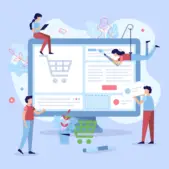UX designers sometimes feel like they’re under pressure to read minds. In fact, this is often explicitly what managers and executives expect them to do.
While it seems an unreasonable request at first, UX design does involve a kind of clairvoyance — just not necessarily a supernatural one. The designer’s foreknowledge of user behavior mostly comes from experience and deliberate rational inquiry.
Experience is something you don’t get until right after you need it the most, but deliberate rational inquiry is a skill that can be taught. Designers who ask the right questions and follow them to their logical conclusion have already won half the battle.
This is the case when requesting information from users. Whenever a sign-up form prompts users to enter their address, phone number, or other private data, users ask themselves, “What are you going to do with my data? Can I trust you? Is this really necessary?” The UX designer’s job is to ask those questions before users do.
Great UX designers use the same approach when diagnosing UX friction. By putting themselves in the user’s position, they are best-suited to help the rest of the team fix friction-related problems.
What Causes UX Friction?
UX friction is the consequence of a mismatch between user expectations and the results that a tool produces. Understanding where those expectations come from is key to addressing the underlying causes of friction.
When it comes to onboarding data, the source is a sense of anxiety about giving up digital information. High-profile cyber attacks and data breaches are a regular part of the news cycle — people are well-advised to feel a bit apprehensive about giving up data online.
Here, the underlying cause is an external factor that is largely out of the designer’s control. When that’s the case, it falls on the designer to develop trust and transparency from the very beginning.
Anxiety can also take other forms. If your application is free, and the majority of competitive products or services on the market are not, you should know that users will be looking for evidence of hidden charges or other bad tactics. A good UX designer will make sure that the application’s cost advantage is reassuringly emphasized at every major step in the user’s journey.
In most cases, the key to identifying the root cause of friction is understanding where the user is in the customer’s journey at any specific moment. Designers who apply this kind of thinking are the ones who appear to read minds.
Mapping Users to the Customer’s Journey
The customers’ journey is a marketing concept that describes every interaction a user has with a brand before making a purchase. The journey also typically includes post-purchase support, cross-selling opportunities, and longer-term goals like customer loyalty.
These interactions usually fall into a sales funnel. Here, their level of connection with the platform or brand is broadly defined as awareness, consideration, or decision. The user expects to move from awareness to consideration to decision seamlessly.
When UX designers understand the objections that users typically have at each stage of the funnel, and engage in proper user research, they can better identify the sources of UX friction.
Giving up personal data during onboarding is a problem that lies within the awareness category. Once a user is considering the purchase of a product or service and actively comparing it to its competitors, giving up personal data tends to be less of an issue as the user is already somewhat implicated.
To eliminate unwanted UX friction, designers need to correlate every action users take with one of these steps. Every click, swipe, or text input has to stand on its own footing as a reasonable expedient that helps users get something done.
Developers and UX designers must collaborate using the customer’s journey as a common starting point. This ensures that both parties are speaking the same language when predicting user expectations and guiding their behavior towards desired outcomes.
A Quick Caveat: Good Friction
Although it might seem clear that the UX designer’s job is to reduce friction, there are exceptions to the rule. In particular, designers need to be wary about users making mistakes at every point in their journey.
You can’t always engineer accidental transactions, security breaches, and nonreversible actions away. Friction can help give users a moment to consider what they’re doing and correct potential mistakes before they lead to frustrating results.
Again, paying attention to how users act according to their position in the customer’s journey is crucial. The customer’s journey map is what helps designers decide where an undo option, security confirmation, or pop-up validation represents real value for users.


